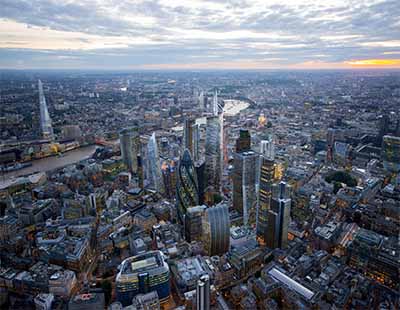Following years of skyscrapers being approved across the country – which has led to the likes of the Gherkin and The Shard in London, and the Anaconda Cut in Salford – the government yesterday decided to reject Foster + Partners’ Tulip Tower, pointing to the tower’s embodied carbon emissions and the impact it would have on the Tower of London and other heritage assets as the reasons for this rejection.
This followed speculation last month that the government would overturn London Mayor Sadiq Khan’s previous decision to refuse planning permission for the flagship project.
However, the government took the opposite view for the planned tourist attraction, with its decision putting to bed years of planning back and forth. This initially started in 2018 when Foster + Partners submitted its plans for the 305m-tall tower for a site by the Gherkin in the City of London.
Although the City of London backed the hugely divisive skyscraper in spring 2019, Khan overturned the decision, labelling the Tulip Tower as an ‘unwelcoming, poorly designed’ mega-project.
Housing minister Christopher Pincher has now confirmed the end of the road for the controversial planning application, after the government decided to follow the recommendation of planning inspector David Nicholson. He concluded the scheme should be rejected following a multi-week public inquiry held in November 2020.
In his report, which was finally published yesterday, Nicholson explained that the purpose, form, materials and location of the planned tower had led to a design that 'would cause considerable harm to the significance of the Tower of London’, in addition to further harming other designated heritage assets.
Nicholson went on: “It would do so for the gains that a new visitor attraction would provide to the economy, tourism and education, which are relatively modest by comparison with the City as a whole and with other nearby provisions.”
He said that ‘achieving the functional requirements at low level in such a constrained space’ had been done with consummate skill, but would not quite ‘outweigh the harm through loss of highly valued public open space and substantial intrusions into the setting to the Gherkin’.
Nicholson’s report added that the plans for the Tulip tower were not of the ‘highest architectural quality’ thanks to the heritage considerations. He also criticised its ‘poor lifetime sustainability’.
He said that, while considerable efforts have been made to adopt all available sustainability techniques to make the construction and operation of the scheme as sustainable as possible, ‘fulfilling the brief with a tall, reinforced concrete lift shaft, would result in a scheme with very high embodied energy and an unsustainable whole life-cycle’.
According to the Architects Journal, a letter addressed to DP9, which is working for Bury Street Properties, outlined that Pincher agreed with the planning inspector ‘that economic and educational benefits would not counterbalance the damage to heritage assets and the other concerns about the proposed tower’.
The letter also said Michael Gove, the recently appointed Housing Secretary, who technically ordered the rejection, agreed with the inspector that the extensive measures that would be taken to minimise carbon emissions during construction would not outweigh the highly unsustainable concept of using vast quantities of reinforced concrete for the foundations, as well as the lift shaft to transport visitors to as high a level as possible to enjoy a view.
Are taller buildings actually on the decline?
Knight Frank releases an annual Tall Buildings Report in conjunction with the NLA - the key takeaways from the latest found that planning permissions for new tall buildings in London were up 10.8% in 2020 compared with 2019.
It also found that planning applications are down 27.1% - however, 73% of these were submitted in the second half of the year, hinting at a rebound in developers’ confidence following the initial economic shock caused by Covid-19 restrictions.
The report found that only 24 tall buildings started construction in 2020 as lockdowns and uncertainty affected work on sites, a fall from 44 in 2019. Meanwhile, the total pipeline (tall buildings in pre-planning, planning and construction) stood at 584 at the end of 2020, up 7.4% from 544 in 2019.
There are also an increasing number of tall buildings coming forward in Outer London boroughs – now standing at 37% of the total pipeline.
Stuart Baillie, head of planning at Knight Frank and a tall buildings expert, said of the Tulip decision: “This has been very polarising Appeal – evident from the vociferous campaigns in favour and in opposition to the scheme. The Tulip ticked many of the boxes of planning policy; it was within the ‘City Cluster’, an area defined as appropriate for tall buildings, and would have optimised its site in the language of the London Plan."
He added: "Ultimately, however, it was the impact on the heritage of the area that swung the decision. In particular the heightened level of concern from the government and Sadiq Khan about the status of our World Heritage Sites – this was almost certainly a driving factor, given that Liverpool recently lost its World Heritage status due to overdevelopment.
"Notably, ESG was also a concern – the purpose of the Tulip may be short-lived and incapable of repurposing in the medium-to-long term. The decision, therefore, is less about design and more about impact. It is a fairly unique case where the grounds for dismissal are very much about the site’s unique circumstance. In this regard, I do not think it sets any significant precedents for other tall building developments across London.”
Lydia O’Hagan, associate at London law firm Charles Russell Speechlys, said of the news: “Gove’s decision may be a sign of more difficult times to come for tall buildings. Steering tall buildings through the planning system is likely to become increasingly difficult with the recent adoption of the new London Plan and upcoming developer taxes.”
She added: "However, despite the challenges, tall buildings also present unique opportunities. They can deliver more floorspace with less footprint, contribute to city life through commercial and residential accommodation and associated facilities, as well as make a positive contribution to skyline, with well-known examples including the Shard and the Gherkin.”
She went on: “With an increased emphasis on brownfield development, there is still a key role for tall buildings of exemplary design in society.”
But what could this decision mean for tall residential buildings in the future? “With the requirement for buildings to be beautiful now national policy, the bar will be set high for future residential towers," O'Hagan said.
"The emphasis on design quality in the revised National Planning Policy Framework was held to be an important material consideration in the appeal and ultimately the Secretary of State agreed with the Inspector that the proposal would not amount to a design of outstanding quality. Design as a whole was considered to carry significant weight against the proposal. Determining whether or not a building is beautiful obviously involves elements of subjective judgement so will naturally introduce more risk and uncertainty for developers and landowners.”
The tower, which would have been designed in the shape of a tulip and offering views to tourists across the capital, has previously been labelled an abomination and even generated a change.org petition against it - albeit with a fairly low number of signatories. It seems like few will disagree with the government's decision on this occasion, going by the strength of feeling against the plans.


















Join the conversation
Be the first to comment (please use the comment box below)
Please login to comment